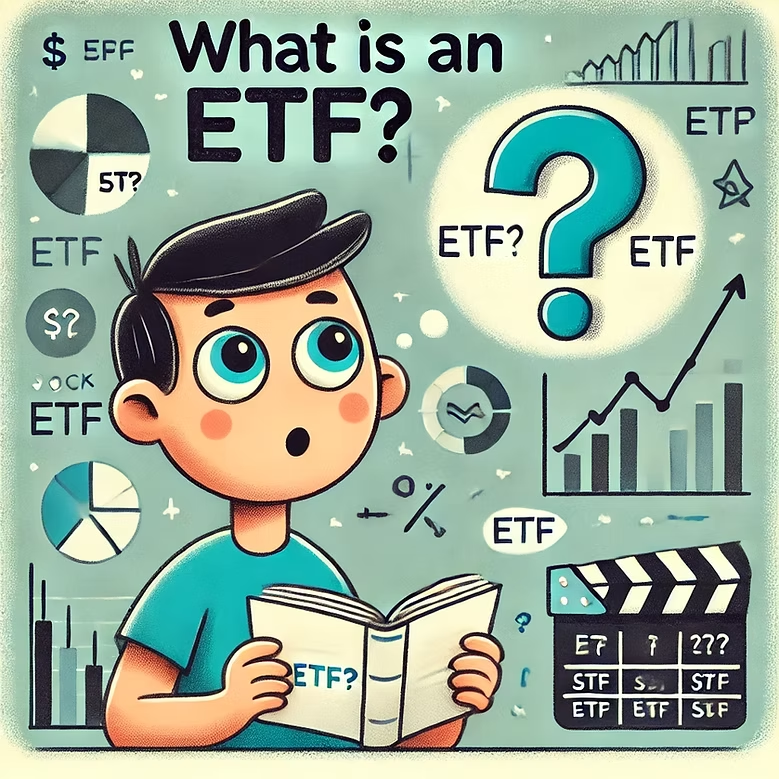
Introduction: what does etf mean?
💡Simple examplewith an ETF ?
Instead of investing in individual stocks such as Apple, Microsoft, Tesla, Google and Amazon, which can be costly and complicated due to the diversity and volatility of the market, you can opt for an ETF on the S&P 500.
This type of exchange-traded fund (ETF) gives you diversified exposure to a basket of stocks, including these large companies, without having to buy them separately.
By buying an S&P 500 ETF, you invest in a fund that tracks the performance of the S&P 500 index, which includes 500 of the largest companies listed on US stock exchanges. This means that, in a single transaction, you can benefit from the rising value of these companies while reducing the risk associated with investing in individual stocks.
How does an ETF work?

Types of ETFs? What is it composed of?
✅ S tocks – Index ETFs (e.g. S&P 500) hold shares in hundreds of companies, allowing diversification without buying each stock separately.
✅ Bonds – Bond ETFs offer exposure to government or corporate bonds and are more stable than equity ETFs.
✅ Commodities – Some ETFs are based on gold, oil, silver or other natural resources. They allow investors to benefit from fluctuations in commodity prices
.✅ Cryptocurrencies – In recent years, ETFs on Bitcoin or Ethereum have emerged, offering exposure to cryptos without the need to hold them directly. We don’t have a good opinion on this, we recommend buying cryptocurrencies directly from platforms like Abarai
✅ Thematic ETFs – Focus on specific industries or trends, such as green energy, artificial intelligence or tech companies.
If you want to invest in tech companies, you can buy an ETF that holds shares of Apple, Microsoft, Google, Tesla and more. This way, you benefit from the growth of the entire sector without being exposed to the risk of a single company.
Advantages and disadvantages of ETFs:
Feature | ETF | Individual shares | Mutual fund |
diversification | ✅ Large | ❌ Small | ✅ Large |
trading | ✅ Real-time | ✅ Real-time | ❌ End of day only |
costs | ✅ Low | ❌ Can be high | ❌ Higher (active management) |
Flexibility | ✅ High | ✅ High | ❌ Limited |
✅ Advantages of ETFs
1. Automatic diversification
ETFs contain multiple assets in a single instrument, allowing investors to diversify their portfolio without buying each stock or bond separately.
💡 Example: if you invest in an ETF that tracks the S&P 500 index, you benefit from the growth of 500 different companies without having to buy shares in each one individually.
📉 Unlike active mutual funds, which have high management fees, passive ETFs have much lower fees.
✅ Most ETFs have an annual management fee (TER – Total Expense Ratio) of between 0.03% and 0.5%, while active mutual funds can be as low as 2% or more.
💡 Example: If you invest $10,000 in an ETF with a 0.1% fee, the annual cost would be just $10. Conversely, in a mutual fund with a 2% fee, you’d pay $200 a year.
3. Easy trading and flexibility
You can buy and sell during exchange trading hours.
The price fluctuates in real time, providing opportunities to enter and exit the market.
4. Access to global markets
💡 Example: an ETF that tracks the MSCI Emerging Markets Index gives you exposure to growing markets in China, India, Brazil and other emerging economies.
5. High transparency
ETFs publish their holdings daily, so you know exactly what you’re investing in. This is different from active mutual funds, which typically only disclose your portfolio once a month or quarter.
💡 Example: if you invest in a tech ETF, you’ll be able to clearly see how many shares it owns in companies like Apple, Microsoft, Google or Amazon.
6. Long-term growth potential
Many ETFs track stock market indexes that have had high returns over time. For example, the S&P 500 has averaged about 10% growth annually over the past 50 years.
💡 Example: If you invested $1,000 in an ETF on the S&P 500 in 2000, today you’d have over $5,000, without frequent buying and selling.
1. You have no direct control over your investments
📌 When you invest in an ETF, you can’t individually choose the stocks or bonds in your portfolio. If an ETF includes a bad company, you’ll be exposed to its risk, even if you wouldn’t have chosen to invest in it separately.
💡 Example: If you invest in an ETF that tracks technology companies and a large technology company goes down sharply, your ETF will be affected.
2. Hidden trading costs
📌 Although ETFs have low management fees, you need to be aware of:
Transaction fees (if your broker charges buy/sell fees).
The price spread (the difference between the ETF’s bid and ask price).
💡 Example: if the ETF has a high spread, you can only lose money on the price difference between buying and selling, especially in volatile markets.
3. Potential lower return than active investments
📉 Because most ETFs are passive and track an index, they don’t try to outperform the market, they just follow it.
4. Not all ETFs are liquid
📌 Some less popular ETFs may have low trading volume, making it difficult to buy and sell them at good prices.
💡 Example: if you invest in an exotic ETF, such as one on emerging markets in Africa, you may have difficulty selling it quickly without losing money.
Conclusions
ETFs are powerful tools for long-term investing, offering diversification, low cost and affordability. However, they are not perfect and should be used according to your financial goals.
✅ They are ideal for investors who want low-risk, low-cost market exposure.
❌ They are not suitable for those seeking quick returns or complete control over their investments.

